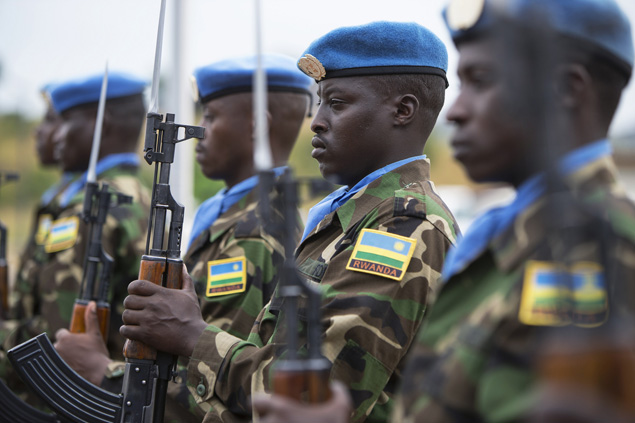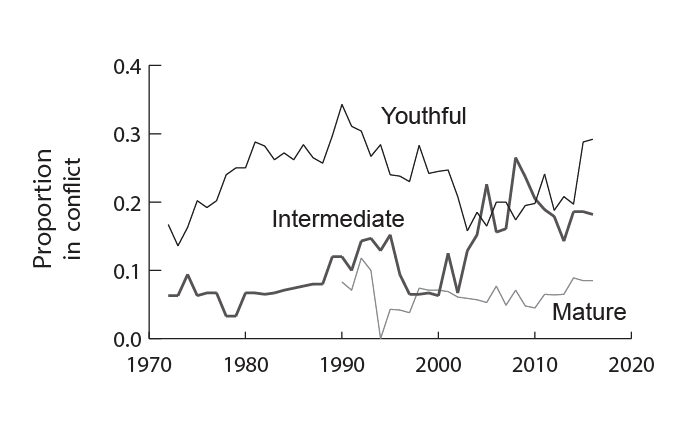-
Age-structure and Intra-state Conflict: More or Less Than We Imagined?
April 19, 2018 By Richard Cincotta
Are younger countries at higher risk of civil conflict? The International Crisis Group’s 2018 list of 10 conflicts to watch suggests they might be: Like last year, intra-state conflicts (civil and ethnic conflicts within states, rather than wars between states) dominate the list, and among those, about 70 percent are within youthful countries, or states with a median age of 25.5 years or younger. The only multi-state cluster mentioned in both 2017 and 2018 lists is the Sahel, the world’s most youthful region.
However, recent studies indicate that population youthfulness can be a less reliable and more unruly predictor than its proponents (including me) initially perceived. Three key factors complicate the relationship between age structure and intra-state conflict: conflict type (civil or territorial); conflict history; and conflict spillover (the cross-border spread of insurgencies among contiguous clusters of youthful countries).
Sommers’ Seven: Revisiting a “Youth Bulge” Critic
Marc Sommers, a sociologist studying African youth in post-conflict situations and a former Wilson Center fellow, has been the most vocal critic of the youth bulge theory. He argues that the youth bulge narrative mischaracterizes the vast majority of young-adult males in youth-dominated societies, and that its narrative inhibits governments from encouraging youth participation, further marginalizing this important group. In a 2011 article, Sommers also asserted that the statistical theory had little future utility because “most of Africa’s recent wars are over.” Sommers cited seven examples of youthful African countries—Angola, Burundi, Liberia, Mozambique, Rwanda, Sierra Leone, and South Sudan—that had formally negotiated peaceful settlements to their conflicts. Although a small set, Sommers’ seven offers an opportunity to assess his critique of the statistical theory in the five years (2012 to 2016) since his paper was published.
The UCDP-PRIO Armed Conflict Dataset indicates that four of the seven states have since experienced intra-state conflict: Burundi (2014-15), Mozambique (2013, 2016), Rwanda (2012, 2016), and South Sudan (2012-16). All of these conflicts were fights to control the central government (civil conflict). And in only one of the 11 conflict years did the intensity of conflict surpass 1,000 battle-related deaths per year (South Sudan, 2014).
Remarkably, from 2012 to 2016, Sommers’ seven experienced a higher proportion of conflict years (31 percent) than the global set of youthful countries (23 percent). Was South Sudan just an unlucky pick? Not really; persistent conflict is common. In 2016, just over half of all youthful countries in intra-state conflict had been engaged in five or more continuous years of warfare.
Expecting Less: The Challenges of Predicting Conflict
It is equally as difficult to use demographic theories to predict near-term conflict. In research published in 2013, five political scientists at the Center for the Study of Civil War at the Peace Institute of Oslo (PRIO) set out to forecast trends in conflict using both demographic and non-demographic statistical relationships. Their simulation relied on projected measures of age structure, population size, infant mortality, and age-specific educational attainment, to which they added static relationships with oil dependency, ethnic fractionation, and the regional neighborhood. To choose the most successful model, the authors rigorously tested alternative versions against data from 2001 to 2008.
Using this simulation, the authors generated optimistic and pessimistic scenarios, stretching from 2010 to 2050. Their optimistic scenario predicted that, as many populations matured, the world could expect a slow decline in future proportions of countries in intra-state conflict. The pessimistic scenario predicted a constant proportion in conflict, stretching from 2012 into the future. Unable to replicate the spikes and troughs observed in prior conflict data, these scenarios were obviously not designed to produce accurate short-term forecasts. Nonetheless, they provide some insight into the difficulties inherent in conflict prediction.
Rather than decline or level off, the proportion of countries involved in intra-state conflict has recently shot upward. By 2016, a larger proportion of youthful countries was experiencing an intra-state conflict than in any year during the past two decades (see Figure 1). Moreover, since 2000, a larger proportion of countries with intermediate age structures (median age from 25.6 to 35.5 years) has been involved in persistent low-intensity conflicts, mostly with ethnic separatists. Only the proportion involved in intra-state conflict in the mature group (median age from 35.6 to 45.5) has consistently remained low (below 10 percent).

Three Confounding Features of Conflict: Type, History, and Spillover
Of the three confounding features of today’s intra-state conflict, the differences between civil and ethnic conflicts loom largest. In a paper published in 2016, Omar Yair and Dan Midownik concluded that, while the risk of the initial onset of civil conflict was statistically related to a country’s youthful age structure, there was no evidence supporting a similar relationship with ethnic conflict. I found similar differences using the UCDP-PRIO Armed Conflict Dataset, which distinguishes intra-state conflicts contesting the government (civil conflicts) from territorial conflicts (warfare that typically pits the government against ethnic separatists). Unlike civil conflict, the risk of territorial conflict is only weakly related to country-level age structure.
However, we may find some clues at the sub-national level, if data are available. Several authors have noted that a persistently youthful minority age structure can be a bellwether for political violence—regardless of whether the minority population is the principal target of violence, or the source of insurgents.
The tendency of countries with a recent history of conflict to experience conflict re-emergence and persistence is another confounding feature of intra-state conflict. Fortunately, states in civil conflicts have typically experienced a decline in risk as they approach and pass through the demographic window—a period associated with low dependency ratios and achievements in social and economic development (e.g., Colombia and Mexico). In fact, the onset of an armed civil conflict in a country at peace, with a median age over 30, is rare.
Sadly, territorial conflicts are less likely than civil conflicts to disappear during the demographic window. Several states that entered the demographic window with territorial conflicts—including Myanmar, India, Turkey, Israel, and Thailand—have seen these insurgencies drag on or periodically re-emerge.
Conflict’s third confounding feature can be called the “spillover effect”: Countries within and around contiguous clusters of youthful states are increasingly placed at risk by the spread of insurgents from a conflict-affected country, which escalate political violence within neighboring countries. Today’s most volatile youthful clusters include the Sahel, the Horn of Africa-Yemen, the Tigris-Euphrates Basin (Iraq and Syria), southern Central Asia (Pakistan, Afghanistan, Tajikistan), East Africa’s Great Lakes Region, and the Congo Basin. Notably, most conflict has been contained within those youthful clusters.
Policy Implications: Promoting Peace—and a More Mature Age Structure
If anything is new, it is an increased awareness of the difficult security conditions occurring in and around the most volatile clusters of youthful states. Unfortunately, there is little indication that any of these youthful centers of political volatility is fading away. Whereas the UN Population Division’s current medium variant projection indicates that about 30 percent of today’s 69 youthful countries are likely to exit the youthful category by 2035, only a handful of these “leavers” are located within today’s most volatile youthful clusters.
Persistence and re-emergence remains the most tenacious of intra-state conflicts’ tendencies. The United States and its allies would be wise to increase their support for UN-organized peace operations, as well as for regional efforts to contain the spread of spillover conflicts. As a long-term strategy, the world’s developed states would do well to increase support for the suite of programs and policies that, in youthful countries, promote the transition to a more mature age structure; encourage greater participation of now-marginalized ethnic and religious minorities; and support those political leaders who show the motivation and political will to implement these policies.
Richard Cincotta is a global fellow at the Wilson Center and non-resident fellow at the Stimson Center.
Sources: Conflict Management and Peace Science, International Crisis Group, International Journal of Conflict and Violence, International Studies Quarterly. Peace Research Institute Oslo
Photo Credit: Rwandan peacekeepers of the UN Mission in the Republic of South Sudan (UNMISS) participate in a ceremony in Juba marking UN Day, October 2013. Photo by UN Photo/Martine Perret.
Topics: aging, conflict, democracy and governance, demography, featured, Guest Contributor, population, security, youth
 A Publication of the Stimson Center.
A Publication of the Stimson Center.







